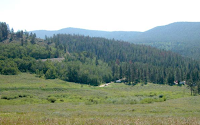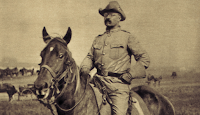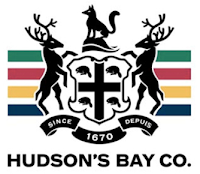A Brief Snapshot, History in the American West
Northwest Colorado has always been abundant with game. The lush meadows and grasslands of
Colorado and surrounding regions support many large game species and wildlife in general. The indigenous species included buffalo, elk, mule deer, pronghorn antelope, moose, bighorn sheep, and more. Mountain lions, black and grizzly bears are native and attracted some of the first adventurous big-game hunters. Fur-bearing animals such as beavers, muskrat, mink, marten, coyotes, wolves, foxes, and bobcats attracted hunting and trapping mountain men. The Yampa Valley is a big nesting ground for many game birds such as geese, sharptail grouse, sage grouse, and sandhill cranes as well. The pioneering of Colorado and the overall civilizing of this area were largely influenced by the ability of this region to support wildlife and livestock. The mining of minerals also had a large impact; however, the romance of the wild west, stories of cowboys, and life on the open range grew as naturally as the grass during the western settlement years.
During the 14th century, northwest Colorado was home to the nomadic Ute Indians. These bands of Indians followed summer and winter game trails. Once the Spanish exposed them to the horse, the Ute Indian culture changed dramatically. They became excellent equestrians, masters of mounted hunting, and easily moved around the western slope. There were two distinct bands of Utes. The Uinta or White River Utes in the south and the Yampa or Yampatika Utes in the north. Both groups summered in the area they called “Medicine Springs”. This is approximately the present-day site of Steamboat Springs. During the winter they moved into lower valleys along the White, Colorado, and Green Rivers (Brown’s Hole).
Fur trappers and Englishmen from the Hudson Bay Company hunted the Rocky Mountain region from Canada to New Mexico as early as the late 1700s until the 1830s. These hunters and trappers supplied the east with fanciful furs and provided beaver pelts for the popular beaver hats of the time. The Rocky Mountain Fur Company and American men like Jim Bridger, Kit Carson, Jim Baker, Pegleg Smith, and others did not move into this region until the late 1830s. Fort Davy Crocket (otherwise known as “Fort Misery”), the first small trading post in the area, opened in Brown’s Hole, now called Brown’s Park, in 1836. In fact, the first place that was actually called a saloon was Brown's Hole. Brown's Saloon, established in 1822, catered to the many trappers during these fur trading days.
Between 1839 and 1855, four recorded expeditions came into the Yampa Valley. The first was led by Thomas Jefferson Farnham. This adventurer recorded the history of the area and described the sulfur cave at Steamboat Springs.
John C. Fremont, “Pathfinder” passed through Routt County on two expeditions between 1843 and
1845. He described the abundant game, outcroppings of coal, and numerous springs and mineral waters of this region. Sir George Gore, guided by Jim Bridger, led a major hunting expedition through what is now called Gore Canyon. Although his party only skirted the Steamboat Springs area, the wagon road forged over Gore Pass in 1855, opened the way for future settlers.
 |
| Gore Pass, Co. |
The Gold Rush, 1848 - 1859
Gold Prospectors and miners followed trails established by the earlier mountain men. Gold was first discovered on a tributary of the Sacramento River in 1848, and on the headwaters of the Platte in Colorado in the spring of 1859. The discovery of gold triggered the greatest mass migration of humans that the world has ever seen. This migration, stimulated by gold mining, was directly responsible for the rise of the Western range-cattle industry.
In 1866, four years after Joseph Hahn and companions found gold in the Hahns Peak area; the first mining district was formed. Two major camps flourished: an International camp named “Bug Town”, and “Poverty Bar”, later called Hahns Peak. Large gold veins were not discovered, combined with difficult and costly transportation, a gold boom never came about. Hahns Peak did take on all the typical characteristics of a gold rush mining camp including liquor, gambling, and even some ladies of the evening. By the early 1880s, there was a general store, livery stables, a hotel, and an eating house. Hahns Peak became the county seat in 1879 and remained so until 1912 when it was moved to Steamboat Springs, CO. Previous to this, the county seat had been located in Hayden from 1877 to 1879. (Historical Guide to Routt County)
Miners and Beef
Gold mining continued to thrive elsewhere; however, the mining population of California and Nevada created a demand for meat that far exceeded the ability of local suppliers to fulfill it. In 1869 the Union Pacific Railroad, building eastward from Sacramento, united at Promontory Point, Utah. This enabled southwestern cattlemen to trail beef animals to Promontory Point and then onto the west coast. The most feasible route was to make a great loop northward from Texas and New Mexico to the Platte River and then head westward via the Oregon Trail. However, in order for the cattle to be marketable, these cattle had to be in good flesh when they arrived at their destination. This meant that the Texas cattlemen found it necessary to “winter” their cattle in a temperate area that would provide good forage during the cold months. (Burroughs - Where The Old West Stayed Young)
Good years or bad, no area was more favorable than Brown’s Hole, now Brown’s Park. Lying in the
extreme NW corner of Colorado, with portions that extend into Wyoming and Utah. This juxtaposition of three states made the “hole” a favorable rendezvous and base of operations for cattle outfits, and any number of drifters, Indians, cattlemen, or the like. Cowboys equipped with six guns, rifles, lariats, a greasy camp kit tied to their saddle, and no other means of support, was a standard sight.
 |
| Brown's Park |
The Romance of The Wild West
Brown’s Park Shangri-La's qualities, isolation, and convenient multi-state boundary access made it an
ideal location for an assortment of horse and cattle thieves, bank and train robbers, and even murderers who drifted in and out of this country. It was the era between the mid to late 1800s and early 1900s that gave way to all the romance and the “wildlife” that characterized cowboys and bad men of this time. Cattle rustling was a standard way of doing business in Brown’s Park and horse thieving was just part of the game. The park was not more than a day or two’s horse ride off the beaten track, which featured a jigsaw puzzle of mountain fastnesses, impassable canyons, cedar breaks crisscrossed every which way by abrupt arroyos, and mile after mile of sandstone cliffs pitted with caves. This country was one vast maze of hideouts made to order for law-breakers. During this time there were no close-pursuit laws in effect, a man only had to cross a state line to find impunity. In fact, a wanted man in Brown’s Park only had to ride a few miles to do so. This added significantly to the “holdout” quality of Brown’s Park.
Significant western characters such as Butch Cassidy, the Sundance Kid, and Harvey Logan, the leader of the Wild Bunch, rose to stardom during this era. Brown’s Park facilitated their interests well as they made their way up the ranks via horse thieving, bank and train robbing.
(Burroughs)
Meeker Massacre - The Tragedy at White River, September 29, 1879
In 1873 the Utes signed the Brunot Treaty, ceding most of their best land to the whites. The White River Agency was created approximately 25 miles from the present site of Meeker. Six years later Nathan Cook Meeker attempted to convert the Utes from hunters to farmers. This imposed change on the Indians resulted in his murder along with his employees. During the same raid, the Indians ambushed the army at the Thornburgh Battle on Mill Creek.
Read the full account in Marshall Sprague’s Massacre: The Tragedy at White River
Coal Mining in Routt County
After the slow down in gold mining. Coal became king in Routt County. Coal was first mined in the
The 1880s. Of the 588 million recorded tons of coal mined in Colorado, 12% of that coal was produced in Routt, Moffat, and Rio Blanco counties. Initially, coal was mined to meet the needs of local residents. The railroad made large mines feasible and profitable in the 1920s through the late ’40s. The mines began to close in the 1940s due to the switch to diesel-powered train engines, and the mine tunnels became so extensive that production costs soared. The remaining two active mines in Routt County were both strip mines. The Edna mine at Oak Creek and the Osage Mine at McGregor. In 1962 steam generated electric plants in Hayden and Craig revived coal mining. By 1979 six coal companies employed 670 men in the operation of eight mines. Most of the mining done during this time was strip mining. (Historical Guide to Routt County)
 |
| Coal Mining in NW Colorado |
Brown’s Park - Western Range-Cattle Industry
The United States Government was perennially at war with one or another tribe of Plains Indians, during the late 1800s. That being the case, the U.S. government viewed buffalo as a mobile commissary or market that provided the enemy with food, clothing, shelter, material for building boats, and occasionally fuel. Hence it was the settled policy of the U.S. gov., to bring complete elimination of the buffalo herds. These, huge prehistoric-looking animals, ranged from the Mississippi River to the Rocky Mountains and from Texas to Canada. Although there was push back to protect the buffalo coming from Texas Legislature. General Phil Sheridan, in command of the Military Department of the Southwest at this time, headquartered in San Antonio, soundly defeated this measure in a joint session of that body.
With the passing of the buffalo, which was more like an open slaughter, the western country became a huge vast sea of unharvested grass. It was not long after the buffalo departed that cattle arrived to take their place. Cattle and cattlemen in fact. The vast plains and mountain meadows of grass were viewed as “Red Gold”. The grass, half a billion acres of it, was free! It was an economic opportunity. With little or no money at all, one could acquire cattle (buy or steal) and run them on the open range, with no additional expense. After two or three years of forging, a calf purchased for $5 would bring $35 - $40 on the eastern market. That was a grand profit for those days and a cowboy lifestyle that many embraced. (Burroughs)
 The Homestead Act of 1862, Railroads and
The Homestead Act of 1862, Railroads and
The Demise of The Range Cattle Business
Two main factors played heavily into the fall of the Northwestern Colorado range cattle business: Sheepman and the Homestead Act. Although the Homestead Act was initiated in 1862 there wasn’t a rush to move into NW Colorado until the addition of the Grazing Homestead Act in 1916. The reason for this was two-fold. First, there was a lack of any roads or railways that accessed this area. The best mode of travel was by wagon; however, roads were not good or limited. In addition to this difficulty, large-range cattle outfits had a stronghold in this region. Just by virtue of how they did business, which was to graze cattle on public lands. They believed that their operations were entitled to grazing rights, driveways (cattle drive routes), and water access. Secondly, there was an ongoing war between the sheepman and the cattlemen. Whereby the cattlemen had a practice of great hostility towards the sheep outfits; which included killing entire sheep herds and pushing them off “their” rangeland. These same tactics were employed upon homesteaders. Due to this, homesteading in this area was not easy. Basically, life in NW Colorado was rough. It wasn’t uncommon for early settlers to be “run-off”. Cattlemen would drive livestock through fencing, eat and stomp plowed field vegetation, and kill livestock. The Grazing Homestead Act allowed new homesteaders to graze animals upon their land regardless of ownership and type of animal. This improved the relationship between the range livestock men and homesteaders. However, not entirely.
In 1887 David Moffat extended his Denver, Salt Lake, and Pacific railroad from Steamboat Springs to Craig, Co., a distance of 42 miles. This extension made Craig, for the next 2-3 years, a large-scale cattle shipping location. However, the traffic was not only in one direction. Automobiles had not become used for general transportation at this time, roads were still primitive. The only means of traveling west was by wagon team or rail. However, the majority of settlers, especially small farmers, preferred the railway. It was not uncommon for a homesteader to load himself, his family, and household goods into one end of a boxcar. Then load the other end of the boxcar with livestock and farm machinery. In December 1915, The Craig Empire reported homestead entries broke records… during that year some 48,592 acres of public land in Moffat County had been filed on by newcomers.
By 1916, with the addition of the Grazing Homestead Act, The Craig Empire headlined: Homestead Bill To Help farmers. This bill enabled land-seekers to obtain 640 acres for $35.00. Up until this time large-scale cattle operations had a hold over the large tracts of public lands. Volney T. Hoggart, a practicing attorney, experienced with land settlement filings, was more than ready to mobilize the public-land policy upon Colorado. Along with his friend and employer, Frederick G. Bonfils, owner of the Denver Post, they realized that the economy of Colorado was not moving forward until the grip the large cattle outfits had over the majority of western Colorado was broken up. It was their combined effort to start a weekly paper tailored for rural Colorado. Additionally, they provided legal support to homesteaders upon joining (for a fee) the Great Divide Colony.
The open range business was in high turmoil during the early 1900s. With the ever-present influx of homesteaders filing claims, setting up farms, and establishing fence lines. Along with increased open range grazing competition between cattlemen and sheepmen, the range itself was in dire condition. Overgrazing became an ever-present issue.
Perceptive cattlemen realized that the quality of beef in addition to quantity was going to sustain their business in the marketplace. These cattlemen began cross-breeding cattle, Herefords with Longhorns, to produce larger, easy weight gaining stock, with higher quality meat. Selective breeding outfits required fencing off pastures in order to manage stock and feed during the winter months.
In 1934 The Taylor Grazing Act was passed. Farrington Carpenter, appointed Director of Grazing, was instrumental in establishing grazing districts. He placed at least one grazier in each district. It was their duty to oversee the proper use of these lands. The rangeland was apportioned on the basis of prior use and who owned private land in the vicinity.
It was upon the effect of the Taylor Grazing Act, inspired by the difficulties of range management and
homesteading, which ended the era of open-range livestock raising business. Theodore Roosevelt, a true Western enthusiast, prophetically wrote: “in its present form, stock-raising on the plains is doomed, and can hardly outlast the century. The great free ranches, with their barbarous, picturesque, and curiously fascinating surroundings, mark a primitive stage of existence as surely as do the great tracts of primeval forest, and like the latter, must pass away before the onward march of our people; and we who have felt the charm of life, and have exulted in its abounding vigor and its bold, restless freedom, will not only regret its passing for our own sakes, but must also feel real sorrow that those who come after us are not to see, as we have seen, what is perhaps the most pleasant, healthiest, and most exciting phase of American existence.”
 |
| Teddy Roosevelt |
(Burroughs)
Read short book reviews about NW Colorado History.



